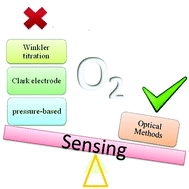Life sensors: current advances in oxygen sensing by lanthanide complexes
Abstract
Aerobes, such as animals, plants, fungi, and several bacteria, depend upon oxygen to live. Consequently, oxygen sensing comprises an emerging technique in many research fields, ranging from medicine to marine science. In the last few years, lanthanide-based oxygen sensors have seen significant progress in the field of optical sensing technology owing to their long luminescence lifetimes and sharp luminescence bands. These sensors provide an alternative to expensive transition metal-based sensors, such as platinum and ruthenium complexes. This review covers the development and design of lanthanide-based oxygen sensors, along with their photophysical properties related to oxygen sensing. These lanthanide complexes achieve oxygen sensing through the excited state quenching of the intermediate triplet state of the antenna chromophore, which suggests that the sensitivity to pO2 arises from the rate of forward intramolecular energy transfer from the antenna triplet state to the accepting Ln3+ ion being competitive with bimolecular quenching by oxygen. As Tb(III) complexes are highly oxygen sensitive, they are favored to be good oxygen sensors, while the sensitivity of Eu(III), Dy(III), Nd(III), and Gd(III) complexes is low.

- This article is part of the themed collection: 2019 Focus and Perspective articles


 Please wait while we load your content...
Please wait while we load your content...